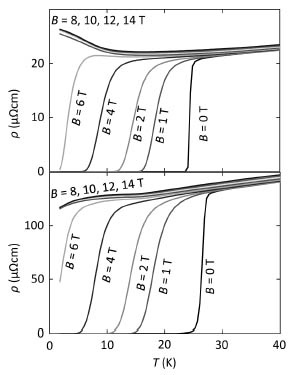Materials Science Laboratory, *Tokyo Univ. of Agricul. & Technol.
The induction of superconductivity in electron-doped cuprates
is associated to an annealing process, quite in contrast to hole doped
cuprates. Hence, while the copper coordination number of hole doped cuprates
is five or six, it is four for electron doped cuprates. These four-fold
coordinated copper ions form two-dimensional, square-planar CuO2 plaquettes. So far it has been believed that the superconducting phase diagram of electron and hole doped cuprates is nearly symmetric with respect to doping in antiferromagnetic-insulating and superconducting orders. For the understanding of high temperature superconductivity it was therefore assumed that the ubiquitous insulating state is prerequisite in the absence of doping.Here we show that the existence of an antiferromagnetic- and insulating order for electron doped cuprates is not mandatory but a consequence of the annealing treatment. We applied the so-called "two-step annealing" process to Nd2CuO4 for the induction of superconductivity. The plain fact that superconductivity
can be induced into insulting Nd2CuO4 is currently being scrutinized by several methods. Here, we only focus
on the superconducting state itself.
Nd2CuO4 (NCO) and Nd1.85Ce0.15CuO4 (NCCO) thin films have been grown by molecular beam epitaxy on (001)SrTiO3 (STO) substrates. NCCO films were annealed in situ whereas NCO films have
been annealed ex situ by two-step annealing procedure [1-4]. Thin films
were analyzed by high-resolution reciprocal space mapping at each annealing
step. A monotonous decrease in c-axis lengths together with a constant
in-plane lattice length are strong indicators for effectively evacuating
apical oxygen sites of as-grown NCO and NCCO. The electronic properties
of NCO and NCCO are nearly identical, i.e., both are metals and the temperature
dependence of the resistivity appears to be Fermi liquid like. The superconducting
response with respect to external magnetic field is shown in Fig. 1 for
NCO and NCCO. The superconducting transition temperature in the absence
of magnetic field as well as the magnetic field dependence shows that in
both cases, NCO and NCCO, the superconducting response is quantitatively
and qualitatively the same. Such a response can be interpreted as follows:
The square-planar coordinated CuO2 plane is a metal and the additional doping only modulates quantities of
band filling rather than a destruction of a long-range antiferromagnetic
order.
[1] Y. Krockenberger et al., Phys. Rev. B85 (2012) 184502.
[2] Y. Krockenberger et al., Jpn. J. Appl. Phys. 51 (2012) 010106.
[3] H.Yamamoto et al., Physica C470 (2010) 1025.
[4] H.Yamamoto et al., Solid State Commun. 151 (2011) 771.
 |
||
|